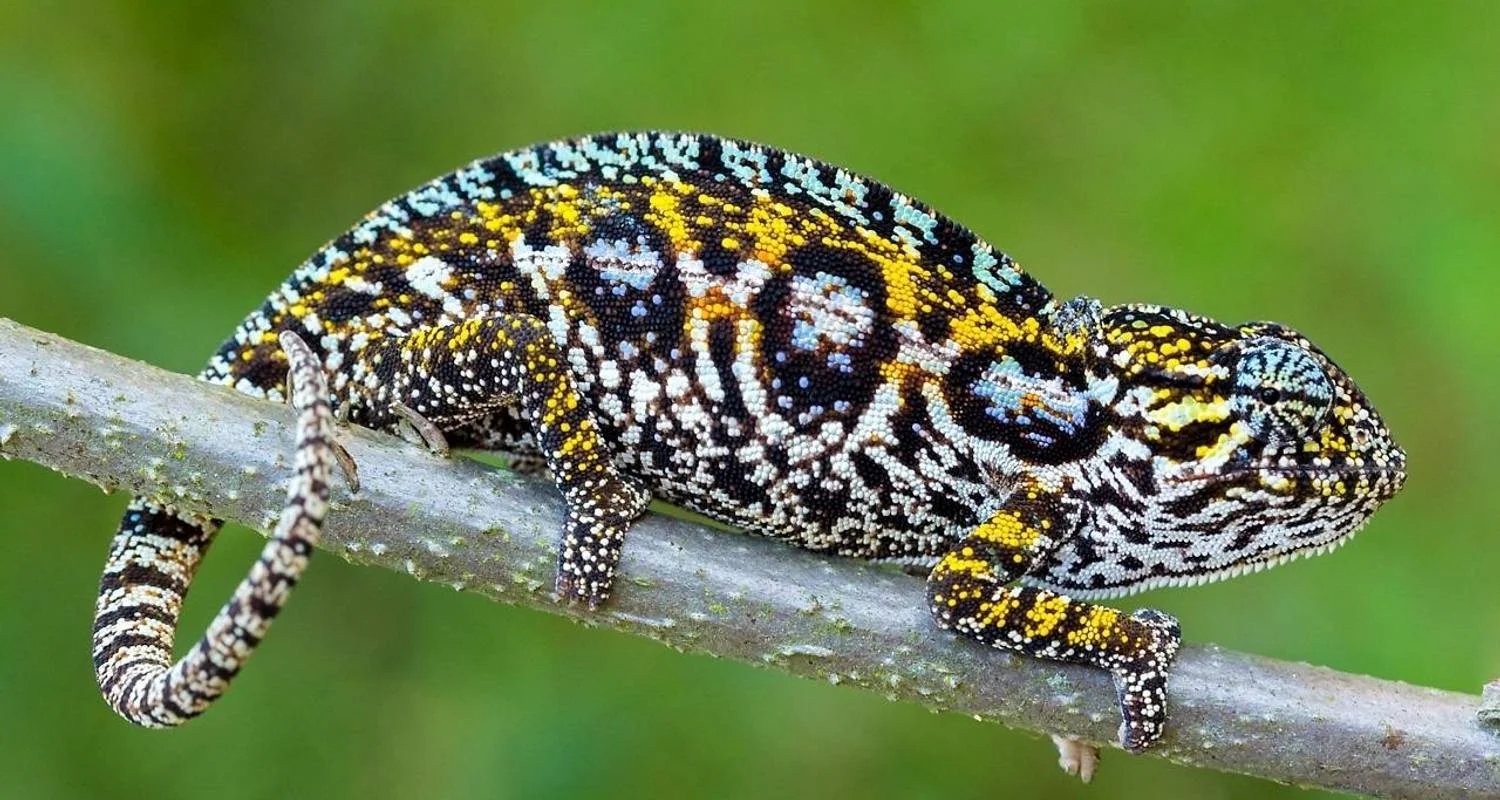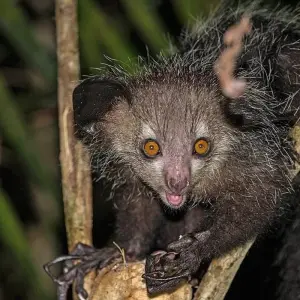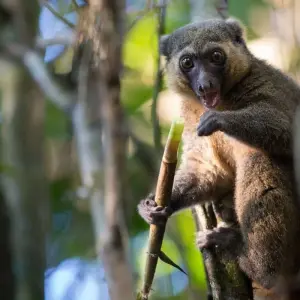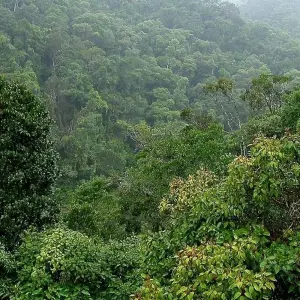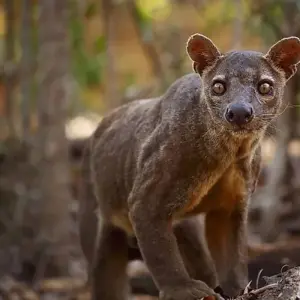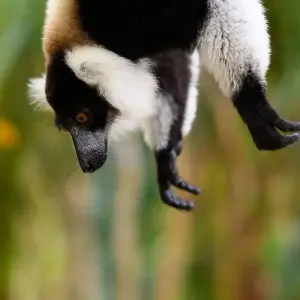This tour will take you from Antananarivo to Andasibe NP, Ankanin’ny Nofy “Palmarium” Reserve, Kirindy NP and Ranomafana NP
• Andasibe – Mantadia National park
Andasibe–Mantadia National Park is about 150 km to the east from Antananarivo, along the RN2, and it can be reached in 3 to 4 hours by car. Comprising two distinct protected areas: Analamazoatra Special Reserve and Mantadia National Park, Andasibe-Mantadia National park is one of the most frequently visited site in the country, and one of the best places to observe lemurs in Madagascar. It is also one of the best primate-watching site in the world. This site is known to be the refuge for a wide variety of lemur species (14 diurnal and nocturnal species), including the famous Indri Indri, the Aye-Aye, the goodman’s mouse lemur, the Crossley’s dwarf lemur, the Eastern woolly lemur sifaka, and sometimes southern black-and-white ruffed lemur. 51 reptile species, 84 amphibian species, 72 mammal species, 117 bird species, and countless insectivorous bats that have been recorded. Mantadia is the one of the best birdwatching site on the Big Island. About the flora, with its lush and green vegetation this protected area contains a collection of evergreen vegetation epiphytic plants (plants living on other plants), palm trees, mosses, fern, bamboo, hardwoods, and precious woods, and pandanus. This park is also famous for its orchids with 120 inventoried species, entirely endemic. They bloom between September and January.
• The Palmarium reserve
The private reserve of Palmarium is also known as “Ankanin’ny Nofy” which translates from Malagasy as ‘nest of dreams’. It is spread across 50 hectares of peninsula land in the Lake Ampitabe area on the East coast of Madagascar, nestled on the banks of the Pangalanes channel and the Indian Ocean. Separated from the latter by thin coastal sand dunes, the landscape otherwise comprises of littoral forest with relatively flat terrain and some well-kept trails for exploration. Palmarium represents one of the most beautiful areas along the Pangalanes Canal, where fishermen float by and go about their daily lives. The isolation of the reserve means it is one of the few places in Madagascar where it is possible to come close to some of the least timid, free-ranging and tame lemur species on the island, including the largest lemurs, the Indri, as well as the famous dancing sifaka. The area is also home to frogs, reptiles, orchids…A rare and endemic terrestrial and arboreal fauna as well as a magnificent flora (orchids, carnivorous plants, ebony, mahogany, traveller’s trees) … the most beautiful palm trees specific to Madagascar, including the rarest varieties (Dypsis, Ravenea, Orania, but also Voanioala and Lemurophoenix).
• Baobabs Avenue
About ten trees 30 meters high border this avenue, of the species Adansonia grandidieri, endemic to Madagascar. Baobabs, over 800 years old, known locally as Renala (in Malagasy for “mother of the forest”), are a heirloom of the dense tropical forests that thrived in Madagascar. The trees did not grow in isolation in this dry and bushy landscape but were part of a dense forest which has now disappeared (only 10% of primary forests remain in the country). Over the years, with the increase in the country's population, forests have been cut down for agriculture, leaving only baobab trees, which locals preserve both out of respect and for their value as a source of food and materials of constructions.
• Kirindy Reserve
Kirindy Forest or Kirindy Private Reserve is a vestige of primary dry forest located in the west of Madagascar, around 60 km northeast of the town of Morondava. It covers an area of 72 000 hectares. This site is part of the New Menabe Antimena Protected Area, located between the Tsiribihina River to the north and the Baobab Avenue to the south. Kirindy forest is home to a wide of animal species endemic to Madagascar, such a lemurs, crocodiles, bats, snakes, chameleons. The flagship species to see in Kirindy Forest is the Fossas. Several habituated individuals hand around the ecolodge, which makes for high quality viewing. However, fossas become more active from October onwards. There are also seven lemur species, including the dancing Verreaux’s sifaka and the red-fronted brown lemur. Night walk tend to be very productive and offer chances to see the Malagasy giant jumping rat, the red-tailed sportive lemur, the grey mouse lemur, the pale fork-marked lemur, and the Madame Berthe’s mouse lemur. In addition to its wildlife, Kirindy Forest is also home to a luxuriant flora. Its tall trees are covered with mosses an epiphytes, creating a unique ecosystem.
• Ranomafana National Park
The Ranomafana National Park is located in the southeast of Madagascar straddling the regions of Upper Matsiatra and Vatovavy Fitovinany. It is 412 km south-east of Antananarivo, 65 km north-east of Fianarantsoa and 139 km west of the town of Mananjary. Terrestrial National Park classified World Heritage Site with its dense low-lying humid forest (600-800m), its dense humid forest of medium altitude (800-1400m), its bamboo forest, its marshland where plant and animal species such as Pandanus, Vareciavariegata variegate, Crayfish, Limnogale Mergulus choose as habitat. 6 species of fish, 74 species of insects, 90 species of butterfly including 4 rare species, 350 species of spiders, 6 endemic species of crustaceans and a subspecies of crayfish of the group of Astacoides. 58 species of reptiles, 98 species of amphibians, 115 of the 257 species of birds of Madagascar the majority of which is endemic. 12 species of lemurs, 7 species of carnivorous mammals and 20 species of insectivores, 07 species of bats including Myzopodaaurita, a monogenous that exists only in Madagascar. There are also 13 species of rodents. The Ranomafana forest is of the rainforest type whose hard core considered as primary forest is distant from the road axis. There are Apocynaceae, Euphorbiaceae and Rubiaceae, Dypsis sp and Phloga sp of the family Palmae, Aspleniumnidus, orchids of the genera Bulbophyllum and Eulophiella. Large areas of secondary forest are occupied by Psydiumcattle yanum of the family Myrtaceae. Tropical hardwoods such as rosewood or Dalbergia sp, maka or Weinmania sp and varongy or Mespilodaphne tapack, are also visible. A profusion of rare plants is also identified: ferns, bamboos and hundreds of orchids. Chinese guava occupies more and more spaces and is dispersed by lemurs and frugivorous birds.

